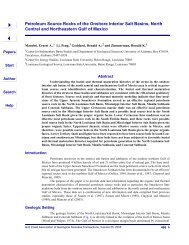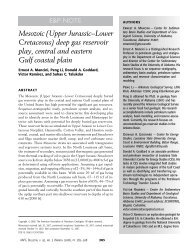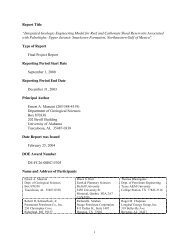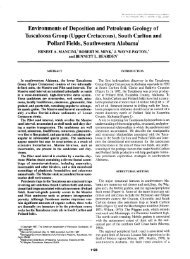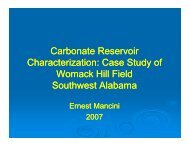Part 4 - Berg - Hughes Center
Part 4 - Berg - Hughes Center
Part 4 - Berg - Hughes Center
You also want an ePaper? Increase the reach of your titles
YUMPU automatically turns print PDFs into web optimized ePapers that Google loves.
following: green, red, and pink conglomeratic lithic arenites and fine- to coarse-grained,<br />
feldspathic arenites, interbedded with red and greenish gray shales and siltstones. Lithic<br />
arenites contain basalt, chert, quartzite, and dolomite rock fragments; plagioclase is the<br />
predominant feldspar. The sandstones have low textural and mineralogic maturities.<br />
Eagle Mills red beds and associated intrusive igneous rocks (diabase and basalt dikes and<br />
sills) represent the fillings of grabens or rift basins that actively subsided during<br />
deposition in alluvial, fluvial-deltaic, and lacustrine paleoenvironments.<br />
Middle Jurassic (Werner, Louann)<br />
Werner Formation<br />
The Werner Formation unconformably overlies both the Eagle Mills and Morehouse<br />
Formations and grades into the overlying Louann Salt; north of the limit of the salt, the<br />
Werner is overlain unconformably by the Norphlet (Bishop, 1967). Hazzard et al. (1947)<br />
mentioned the Werner contains a lower red bed member consisting of red shale and<br />
sandstone, commonly conglomeratic at the base, and an upper anhydrite member of<br />
relatively pure, dense, granular anhydrite. They reported that the members are<br />
conformable, and that the Werner-Louann sequence represents a continuous cycle of<br />
deposition.<br />
The Werner anhydrite underlies the greater part of south Arkansas and is present in<br />
north Louisiana. About 50 ft of red beds and sandstone between the Werner anhydrite<br />
and the dark shale of the Morehouse in the A-1 Tensas Delta well is probably the<br />
equivalent Werner red bed member. Several workers in the region have reported apparent<br />
excessive thickness of Louann Salt as compared to the average 50 to 100 ft of underlying<br />
Werner anhydrite (Andrews, 1960).<br />
349




